High Season on Mt. Washington
Each spring, thousands of skiers flock to Tuckerman Ravine to ski big mountain terrain. But there’s more to do than just ski: bring a bike, and plan to climb, hike or paddle as well.
Under an expansive blue sky, Andrew Drummond takes a deep breath, savoring something rare: still, warm spring air at 5,000 feet on Mt. Washington. He locks his heels down in his alpine touring tech bindings and surveys his surroundings: the expansive white of the mountain’s upper snowfields and the Bigelow Lawn. Ahead of him, the white disappears over a rolling lip: the headwall of Tuckerman Ravine—with lines as steep as 55 degrees, it’s one of the longest pitches in the East.
With one big pull and a nod to his ski partner, he launches over the edge into nearly 600 feet of soft corn snow below. At the bottom, he’s met with a wall of sound: cheers, laughter and hoots from fellow skiers wearing everything from bathing suits to Gortex and tutus.
It’s May and at Lunch Rocks, a pile of boulders conveniently located about halfway up the cirque, the annual pilgrimage to Tuckerman is in full swing, with crowds basking in the spring sun. There are sleds, inner tubes and volunteer ski patrollers. You can smell balsam and despite the activity, it never feels crowded. David Goodman of Waterbury, Vt., author of Best Backcountry Skiing in the Northeast, calls Tucks “a place of pilgrimage for East Coast skiers, where ordinary folks shed their workaday personae and, for a moment, live large.”
At 37, Drummond, a native of Conway, N.H., and the founder of the backcountry shop Ski the Whites, has skied the headwall hundreds of times in both winter and spring conditions. He’s skied steep lines in Alaska, worked on oil rigs, run 100-mile trail races and just won his fifth Tuckerman Inferno Pentathlon, a race that challenges competitors to ski the headwall, bike, run and hike through the Whites and then paddle the Saco River in a day. At 12, he tomahawked several hundred feet down the Tucks headwall, something he calls a “rite of passage.” He’s kept coming back for more since.
“The thrill comes from the fact that you can’t see what’s below you. It is the steepest section of terrain in the White Mountains and the only one that requires you to drop in on a blind roller. The thrill of that still gets me every time.”
But on a good day, when the snow is soft and stable, Tuckerman Ravine can be a friendly place. “It can feel like a blue square ski run if the conditions are right,” says Drummond.
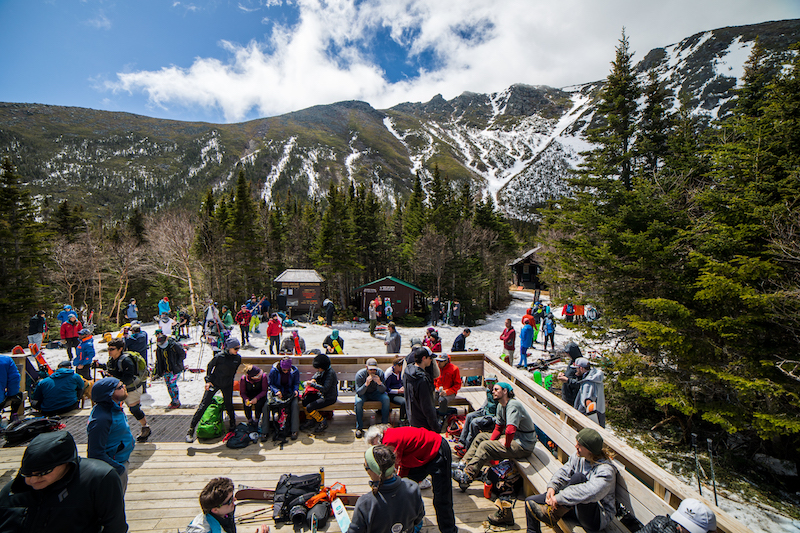
And there are plenty of events to draw skiers and climbers to Mount Washington year-round: Mount Washington Valley Ice Fest happens in early February and the Mt. Washington Backcountry Ski Festival runs annually in March and in April.
May is when the biggest party happens. Slackfest is an annual impromptu barbecue held on the East Snowfields over Memorial Day Weekend, when the Mt. Washington Auto Road typically is open. Expect grills, lawn furniture, straw hats and scrappy skiing on a makeshift slalom course. In June, skis get switched out for running shoes in the Northeast Delta Dental Mt. Washington Road Race, held June 15 this year. Held August 17-18, the 47th Annual Mt. Washington Auto Road Bicycle Hillclimb is known as the toughest hillclimb in the world. But with the snowpack what it is, this month, it’s all about the skiing.
All About the Timing
Historically, early April to May is when the skiing on Mount Washington is best—in large part because the winter’s snow has consolidated into a dense base that softens into perfect corn when the sun warms it to above freezing temperatures by mid-morning. Mount Washington’s variable weather can still create unstable snow conditions for wet slab avalanches (see sidebar: Staying Safe on Mt. Washington)—but stable conditions are more frequent than in mid-winter. This year’s snowdepth of more than seven feet at the bowl’s base should have skiers skiing late into June.
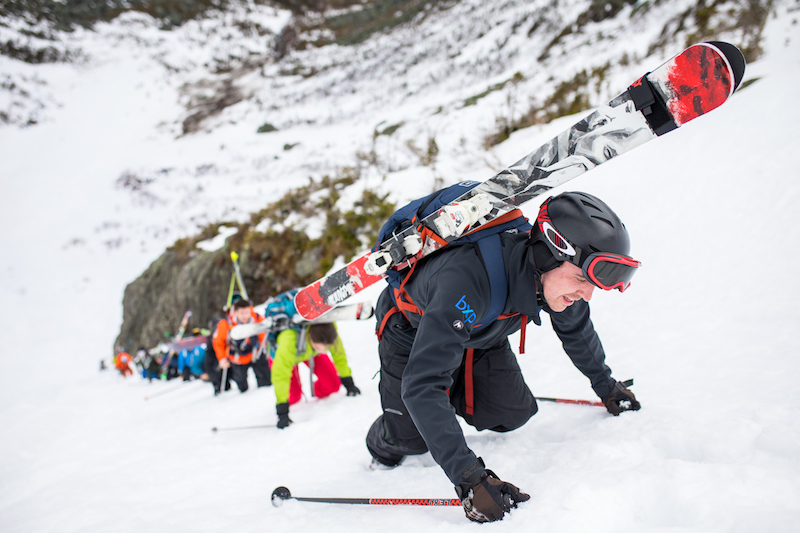
“You want to catch routes while they are in the sun so they’ve corned up by the time you get to the bowl,” says Drummond. This means getting to the base of the headwall between 8 and 10 a.m. It takes about two hours to get there from the trailhead at Pinkham Notch Visitors’ Center. “Right Gully is the most south facing and gets light first,” says Drummond. Skiers climb by bootpacking up their intended route of descent and it’s common for snow staircases to form in the ravine. However, late afternoon shade can make for dangerously icy conditions conducive to a long fall. Crampons are recommended. “Nothing good happens after 3 p.m. in Tuckerman Ravine,” warned Drummond.
Once the Mt. Washington Auto Road is open, skiers can gain quick access to routes on the East Snowfields off of Mt. Washington’s summit. For advanced skiers, Airplane Gully in the Great Gulf Wilderness is a popular late season run on a good snow year. Narrow, steep and rocky, it is most easily approached from the Auto Road in May.
On the west side of Mt. Washington, if you skin up the path of the Mount Washington Cog Railway, it’s just a two-mile approach to access Burt and Ammonoosuc Ravines. The cog railway path sees far less traffic than Tuckerman Ravine but can offer some great corn snow skiing. From 2003 to 2006, the cog railroad operated into the winter, bringing skiers and hikers a mile up the mountain. Today, it operates during the summer only, and on June 22, the railroad celebrates its 150th anniversary with special presentations, a firework display and more at a special gala.
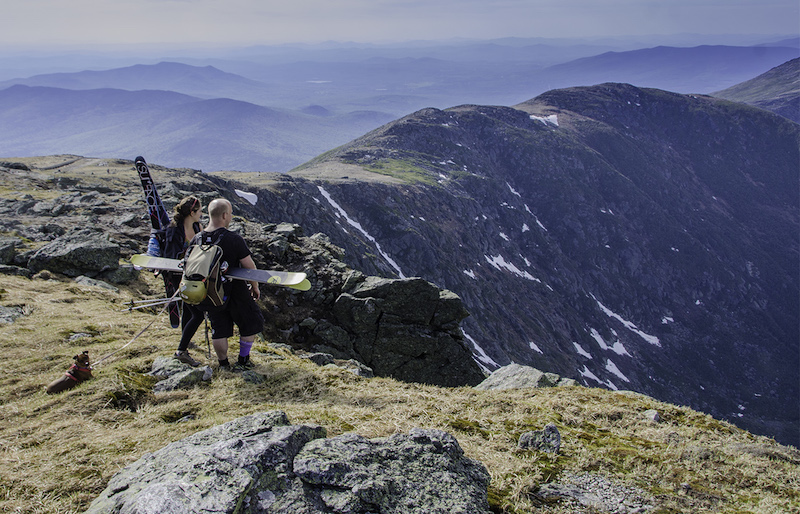
With 1,400 feet of vertical drop, Hillman’s Highway is the longest ski run in the ravine. It’s also a good place to access the remote and more moderate gullies in Oakes Gulf, at the edge of the Dry River Wilderness. For the technical ski mountaineering lines named in Chris Davenport’s 2010 book “50 Classic Ski Descents of North America,” head to Huntington Ravine.
“Every year, you’re waiting for that one classic spring day at Tucks,” says North Conway local and former Volkl East Coast Race Coordinator Alex Leich. “Starting in early April, it’s a good idea to just keep an eye on the weather. Be willing to go up to the base and choose not to ski if the conditions aren’t what you hoped for. Have a back-up plan in the valley.”
Rick Wilcox, who owns the gear shop International Mountaineering Equipment and has guided rock and ice climbing and skiing in the White Mountains for more than 30 years, suggests looking at the forecast for Jackson, N.H. “You want it to be about 50 degrees in the valley and to have hovered around freezing overnight. You also want there to be relatively little wind and plenty of sun,” says Wilcox. Check the Mt. Washington Avalanche Center forecast for avalanche danger and other hazards like crevasses, falling ice, bulletproof ice and glide cracks.
“When I go up to ski Tucks and time it right, it’s like a reunion. I see all my industry friends, pals from ski racing in high school. Think end-of-season party at a West Coast ski resort but in the New Hampshire backcountry,” says Leich.
Bring Bikes, Ropes and Bathing Suits
May and June, when the temperatures are cooler and the area is less crowded, are also great months to get on some of North Conway’s world-famous granite slabs and massive buttresses. It’s one of the few places in the East where you can find multi-pitch granite dome climbing that lets you follow one crack system for hundreds of feet.
At Cathedral Ledges in North Conway, there are more than 60 established rock climbs, among them classics such as Thin Air, a 4-pitch 5.6 traditional crack climb on Cathedral’s 500-foot exposed granite face.
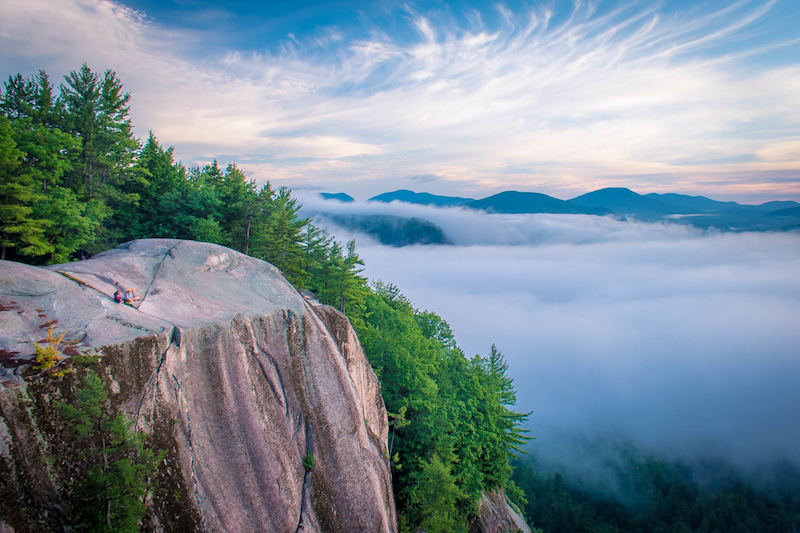
The adjacent Whitehorse Ledge is to slab climbing in the East what Cathedral is to crack climbing. “It all depends on the year, but you can often climb the Standard Route on White Horse Ledge by early April. With nine pitches, at 5.5, it’s a real classic,” says Cheyenne Chaffee, an AMGA Certified Rock Guide for Eastern Mountain Sports School in North Conway.
For sport climbing in May and June, head down the road to Humphrey’s Ledge. A perk of climbing early? “It’s a slow time of year here and tends to be less crowded,” says Chaffee. Rick Wilcox adds that bug spray is necessary starting in mid-May. Pick up the latest edition of North Conway Rock Climbs at I.M.E., the go-to gear shop for mountaineering on Main Street with an epic consignment section. Hire a guide at Eastern Mountain Sports Schools, Northeast Mountaineering, International Mountain Climbing School or Cathedral Mountain Guides.
Every summer, thousands of people flock to Pinkham Notch to hike Mt. Washington. At 6,288 feet, it’s the tallest peak in the Northeast and offers access to more than 20 miles of hiking above treeline. Nicky Pizzo, trails director at the Appalachian Mountain Club’s Pinkham Notch Visitors’ Center, recommends the 2.8-mile Liebeskind’s Loop out of Pinkham Notch if you’re looking for a moose encounter or quiet early season hike.
The trail moves through lush woods and over two small peaklets to Lila’s Ledge, which features an amazing view of the Presidential Range, and Brad’s Bluff. If you’re looking to get above treeline and still lose the crowds, try hiking through the Great Gulf Wilderness from Pinkham Notch to Low’s Bald Spot. This 4.4-mile roundtrip hike offers views of some of the highest peaks in the East. The Great Gulf is a deep and narrow wilderness, walled by the steep ridges that culminate in Mt. Washington and Mt. Madison. It has lush waterfalls, great wildlife and sees few hikers. “This year, snow will linger into May, so call the local ranger station or Appalachian Mountain Club for a trail and weather report before setting out,” says Pizzo.
Starting Memorial Day weekend, Saco River Tubing Center and Saco Canoe Rental Company offer inner tube rentals, canoe and kayak rentals and shuttled trips on the sandy Saco River, which flows through North Conway. Ask them for the latest beta on the river’s many rope swings. The water is cool but clear and has great fishing. Some sections offer whitewater riffles, the perfect place to try your hand at whitewater canoeing.
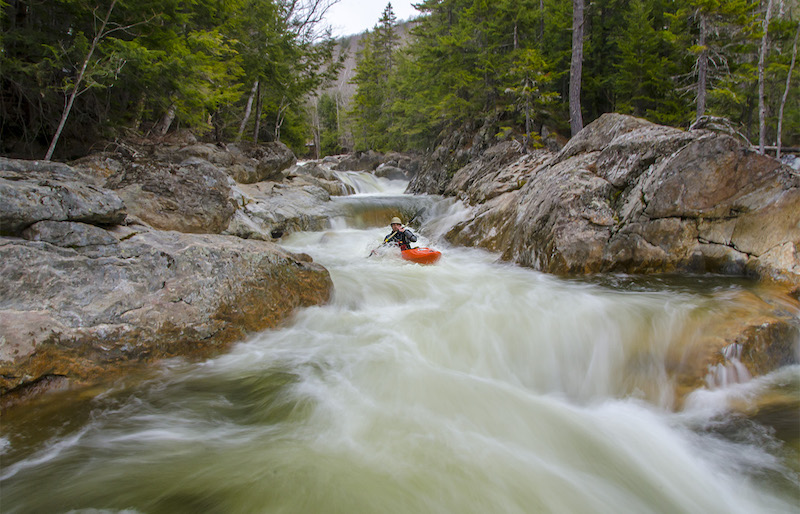
And you may want to bring your mountain bike. “Unlike in most of the Northeast, it can be mountain bike season and backcountry ski season at the same time in the Mt. Washington Valley,” says Leich, who is also vice president of the White Mountains New England Mountain Bike Association chapter. “Our soils tend to be made of decomposing granite, so they drain water better than in Vermont.” He recommends exploring the East Side trails in North Conway for cross-country riding in May and June.
North Conway has become known for steep trails that wind through lush forests. They tend to be technical and rooted, with granite slabs that offer plenty of thrills. The Twilight Zone, accessible from the Walmart parking lot, is one of the first trails to dry out in early May. It drops for two miles of singletrack along the southern ridge of Rattlesnake Mountain to connect with Outer Limits, a 5-mile trail of old-school singletrack featuring twisting narrow sections and some climbing.
Over in Gorham, check out the newly developed trails at Moose Brook State Park created and maintained by the Coos Cycling Club. It has more than 20 miles of riding plus access via the Presidential Rail Trail to new beginner-friendly trails along the Androscoggin River at Power Island and Pine Mountain. Download trail maps at nemba.org/chapters/wmnemba.
Endless Adventure
“On those days when the snow is good, it’s almost less about skiing the headwall and more about socializing,” says Drummond. “When the conditions are right and you get that spring hero snow, the terrain becomes less intimidating. You see all skier abilities getting out there, from novices to experts dropping huge cliffs.”
For Drummond, that atmosphere is representative of the valley where he grew up. “It’s a rare moment to be up on Mt. Washington with thousands of people, all skiing the same terrain together.” And it marks the start of something new: summer. “There is so much to do in the White Mountains. The access is incredible and it’s there for all of us who live in the Northeast. Between the incredible trail running and hiking, the mountain biking, you could spend a lifetime trying to explore these mountains.”
Where to Eat, Drink and Stay
Plan to spend a weekend at Mt. Washington and you’ll discover big mountain terrain right next to villages supported by local farms, packed with mountain town culture and new places to eat, drink and stay. For more about all of the adventures you can have and where to play, see “High Season on Mt. Washington.”
In North Conway, try the malty Headwall Alt at Tuckerman Brewing Company, where from June through August, you can catch live music outdoors in the brewery’s field on select weekends, with food trucks and lawn games. For another North Conway classic, check out Moat Mountain Brewing Company for locally sourced pub fare like the Long Horn Nachos, which feature house-smoked local brisket. If you’re looking for the locals’ late-night scene, head to The Red Parka Steakhouse and Pub in Glen.
Table + Tonic, which opened in North Conway in June 2018, offers “Garden to Glass” craft cocktails and farm-fresh food. Owners Heather Chase and Russ Van Deursen source many of the herbs and berries that go into their house-brewed liqueurs, bitters and syrups on their farm in neighboring Intervale, called Mountain Flower Farm. They also own the health food store in town, The Local Grocer. For more upscale farm-to-table dining head to Thompson House Eatery in Jackson, home to the outdoor Jackson Farmers’ Market on Tuesday evenings. Since winter 2017 chef-owner Jeffrey Fournier and his wife and co-owner Kate have used locally-sourced ingredients to shape their creative menu, which features dishes like the southern-style shrimp and grits with pickled green strawberries, North Country kale, cheddar and parmesan and Abita Turbodog beer.

For breakfast, check out the homey Stairway Café on Main Street and order the elk sausage with your eggs while you peruse their collection of vintage White Mountain guidebooks. Other well-loved diners include the Sunrise Shack in Glen, and in North Conway, Priscilla’s, Peach’s

Restaurant and the Old Village Bakery. At 27 North, which just opened in North Conway in December 2018, try one of the house-infused Bloody Marys while you tackle “The Sinner,” an egg scramble with homemade corned beef hash, chunks of bleu cheese and bacon or take on the Garden of Eatin: eggs hollandaise with Portobello mushrooms, broccoli, feta and scallions. You can even get Lobster Benedict, topped with asparagus and cheekily named “The Saco.”
For coffee that will kick you in the pants and free wifi, head to Frontside Grind in North Conway. Glen Beverage Co. is the place to pick up craft beer for your post-Tucks parking lot reward, with more than 300 brews in stock.
There’s so much to do, you may want to make a weekend out of it and find a place to stay. If you’re skiing Tuckerman Ravine, you can skip the early morning 2.4-mile approach via the Tuckerman Ravine Trail by reserving a spot in one of the eight lean-tos at the Hermit Lake Shelters ($15 per person per night, outdoors.org) operated by the Appalachian Mountain Club. Come spring, it’s a great place to meet fellow skiers, learn about conditions and swap stories and beers. Be sure to catch the alpenglow on the headwall at sunrise from the deck of the caretaker’s cabin, affectionately known as “HoJo’s.” In Pinkham Notch, the AMC’s Joe Dodge Lodge has shared and private rooms for $83 to $95 per person per night.
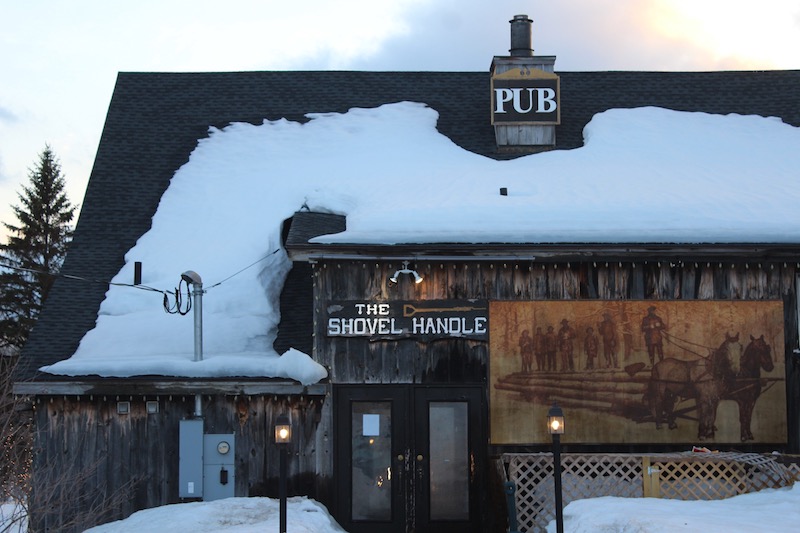
At White Mountains Hostel in downtown North Conway, bunk down for as little as $22 per night in a room likely shared with other climbers and skiers. In the summer, take a walk to the Saco River and check out the rope swing.
In Gorham, 20 minutes from Pinkham Notch Visitors’ Center, stay in a yurt (open Memorial Day through October) or the main lodge at HubNorth ($90-$360 per night), which opened in 2017 and is located on a 20-mile network of mountain bike trails—ranging from advanced singletrack to rail trail, developed and maintained by the Coos Cycling Club at Moose Brook State Park. Grab an apres-ski beer at SAaLT Pub.
The new Glen House ($99-$400 per night) opened in September 2018 across from Great Glen Trails, at the base of the Mount Washington Auto Road. The big main lodge features views of Mount Washington, exposed wooden beams and a big fireplace.
For a true great camp experience, especially if you plan to ski the cog or any of the routes on the West side of Mt. Washington, stay at the Omni Mt. Washington Resort at Bretton Woods ($190-$500). Since 1902, the grand hotel has hosted presidents, poets and celebrities and earned a reputation for fine dining, its spa, beautiful architecture and stunning views. It sits at the base of Mt. Washington, just minutes from the Cog Railroad in the summer and the trailhead for the Ammonoosuc Ravine trail, a challenging but stunning ascent to the AMC’s Lakes of the Clouds Hut.

Featured Photo Caption: On a sunny spring Saturday when the conditions are just right, hundreds of skiers flock to Tuckerman Ravine. Photo by Andrew Drummond
Staying Safe on Mt. Washington
On Thursday, April 11, a skier was buried by an avalanche on Mt. Washington. According to a report by Frank Carus, the U.S. Forest Service’s Lead Snow Ranger and Director of the Mt. Washington Avalanche Center: “A solo skier, skiing Raymond’s Cataract triggered a wind slab above the waterfall zone as the terrain rolls over. The victim was buried about a meter deep.” Webcam footage indicates the slide occurred at about noon, but the snow rangers were only notified that a skier may have been involved at 1:30 p.m. Though he was freed by about 2:20 p.m., he was buried for just over two hours. “We dug him out and he was breathing, but cardiac arrest soon followed. We worked on him at the scene with vigorous CPR.” The skier, Nicholas Benedix, 32, died before he could be transported to a hospital.
Though the avalanche conditions had been described as “moderate” that day, Raymond’s Cataract, as Carus went on to describe it, “is a classic terrain trap— you can see where debris funnels down.” The crown of the avalanche was 130 feet wide and a meter thick, triggered at a convex, 39 degree bulge. Carus described the snow conditions as “pencil-hard windslab over softer snow.”
Avalanche warnings have been posted on many days this spring. The day prior, on April 10, a smaller slide slid down higher terrain. Earlier this spring, larger slides swept the ravine. According to Randi Minetor, author of Death on Mount Washington: Stories of Accidents and Foolhardiness on the Northeast’s Highest Peak, published in 2018, 13 people have died in avalanches on Mt. Washington since 1849, when data first was recorded regularly.
Chris Joosen, the U.S. Forest Service’s former lead snow ranger and head of the Mount Washington Avalanche Center until his retirement in 2016, posted this to the Center’s blog in 2013:
Of the nine avalanche fatalities I have dealt with since 1991, 6 climbers died primarily due to trauma while the 3 skiers died due to a combination of asphyxiation and trauma. New Hampshire, and more broadly northern New England, leads our nation in the percentage of avalanche deaths that result from trauma. Our terrain and generally low snowfall create scenarios that bring us into rocks, over cliffs, into the trees more often as we hunt for areas to pursue our sports. Our ability to ski tour in open terrain or stick to low angle slopes in avalanche terrain is near impossible in most cases. Of the nine aforementioned avalanche deaths on Mount Washington, four occurred under a Moderate or Moderate moving towards Considerable rating and two under a High rating in Tuckerman and Huntington Ravines. The remaining three fatalities occurred in the Gulf of Slides, where avalanche advisories are not issued. In the two incidents leading to these three deaths the avalanche danger in Tuckerman and Huntington was posted at High.
While avalanche conditions tend to lessen later in the spring, other hazards such as crevasses and moving streams hidden by snowpack, emerge. Carus, and Ryan Matz, Backcountry/Wilderness Manager at WMNF have this advice for anyone who plans to hike or ski the high country at Mt. Washington.
Know the snow conditions and forecast. Get the latest forecast for the valley and for the mountains at mountwashington.org or at the front desk at the AMC’s Pinkham Notch Visitors’ Center. Know that it will likely change. If you are heading to elevation, check mountwashingtonavalanchecenter.org to get the latest information about avalanche danger, snowpack and current hazards in the ravine. Check the WHIVCH bulletin again when you get to the caretakers’ cabin for any changes to the reported conditions and be prepared to change your plans.
Be prepared for avalanches. Be prepared with avalanche gear (transponder beacon, probe and shovel) and know how to use it in the event of an avalanche. Visit kbyg.org for more about how to stay safe in avalanche terrain.
Carry the essentials. Make sure you have maps and a compass, headlamp, sun protection, insulation (think layers), a headlamp, first aid kit, a fire source, knife, food, plenty of water and emergency shelter.
Wear a helmet to protect against falling rocks, snow or a fall in the ravine.
Carry an ice axe and crampons. Know how to self-arrest in the event of a sliding fall.
Be aware of falling ice, glide cracks and waterfall holes. Hike up your intended line of descent so you can see any crevasses that have opened before you put your skis on to descend. Waterfall holes are especially prevalent in the lip of the ravine, where they can be invisible from above. Be aware of the potential for ice fall at Lunch Rocks late in the season. Don’t hang out under ice formations. Listen for running water under the snow to avoid snow bridges.

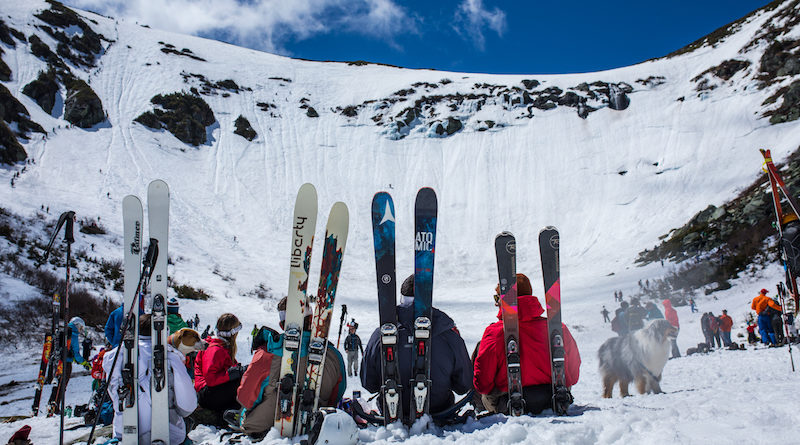
Pingback: Cody Townsend Skis Mt. Washington – VT SKI + RIDE